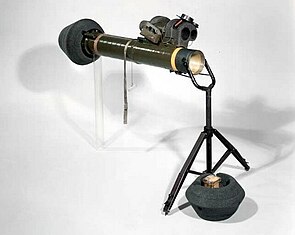M47 Dragon
| M47 Dragon | |
|---|---|
| General Information | |
| Type | Anti-tank guided missile |
| Local name | M47 |
| NATO designation | FGM-77 Dragon |
| Country of origin |
|
| Manufacturer | McDonnell Douglas , Raytheon |
| development | 1966 |
| Commissioning | 1975 |
| Unit price | $ 4,500-6,700 (rocket) |
| Technical specifications | |
| length | 1.15 m |
| diameter | 127 mm |
| Combat weight | 16.1 kg |
| span | 340 mm |
| drive | Solid rocket engine |
| speed | 200 m / s |
| Range | 1,500 m |
| Furnishing | |
| steering | SACLOS , via wire |
| Warhead | 2.5 kg shaped charge |
| Detonator | Impact fuse |
| Lists on the subject | |
The M47 Dragon is an American anti-tank guided missile (PAL). It is the predecessor of the FGM-148 Javelin and is still used today by numerous armed forces .
history
The development of the Dragon was commissioned by the US Army Ordnance Missile Command (AOMC) in September 1959. The goal was to develop a heavy yet portable version of a PAL. In August 1964, a contract was signed with McDonnell Douglas , which included a twelve-month test development for a PAL with a range of 1000 m.
The Dragon was first used in the field in 1975 by the US Army and the US Marine Corps . At the beginning the range of the missile designated as FGM-77A was a maximum of 1000 m, the flight speed 100 m / s. In 1985 the Dragon was upgraded to the Dragon II , which had greater penetrating power. The current model is called Super-Dragon and was introduced in 1990. The Super-Dragon can penetrate armor up to 450 mm thick and has an improved range of 1500 m.
The aiming device consists of a smooth, fiberglass-reinforced plastic tube, a target finder and a loop; a night vision device can be retrofitted if necessary. During use, the shooter stays in a standing, sitting or kneeling position and directs the missile into the target; subsequent corrections are possible via a wire that connects the missile to the target device. The biggest disadvantage here is that the shooter loses cover after takeoff and offers an easy target for the enemy.
Since the missiles of the Dragon are relatively expensive, a mobile, battery-powered simulation unit is normally used for training on the weapon. The normal weapon that fires a missile is not used, but a simulation weapon that is very similar in appearance and feel. When firing, a larger mass is suddenly shifted by a pre-tensioned spring, which simulates the recoil-free exit of the rocket from the shoulder-supported launch tube. In contrast to the real start, the weight of the simulation unit remains on the shooter's shoulder after the simulated firing of the rocket, which makes aiming difficult (during a real start, the shoulder is relieved of the weight of the rocket being fired). In addition, when fired, a pop petard ignites with a lot of smoke. After the start, the fictitious deviation of the target aimed by the shooter and the effective target can be graphically displayed, logged and evaluated on a simulator connected via cable. The target consists of a triple mirror that uses retroreflection to send the infrared signal emitted by the simulation weapon back to a receiver on the target device. The mirror is handy and easy to attach to stationary or moving targets.
The United States Armed Forces officially decommissioned the Dragon in the late 1990s, but the Dragon's arsenals are still in holdings.
Switzerland
The Dragon was introduced into the Swiss Army in 1977 under the name PAL BB 77 (for anti-tank guided missile ground-ground 1977 ). To combat armored vehicles, the PAL platoon usually uses prepared rifle positions from which it acts on the targets. The shooting groups each have a target device with them that they alternately use or mount on their starting container.
In the course of time, the Swiss Army introduced four generations of guided missile ammunition for the Dragon: PAL BB 77 HPz G (hollow shell grenade, Army warehouse number 591-3280), PAL BB 77 HPz G 86 (ALN 591-3281), PAL BB 77 HPz G 90 (591-3282) and the PAL BB 77 HPz G 00 (591-3283) in 2000. The latest generation of the upgraded Dragon can also penetrate reactive armor .
The PAL Dragon was decommissioned and liquidated on January 1, 2008 because of its disproportionately high maintenance costs.
Illustrations
- M47 Dragon
Control missile lights ( long exposure )



